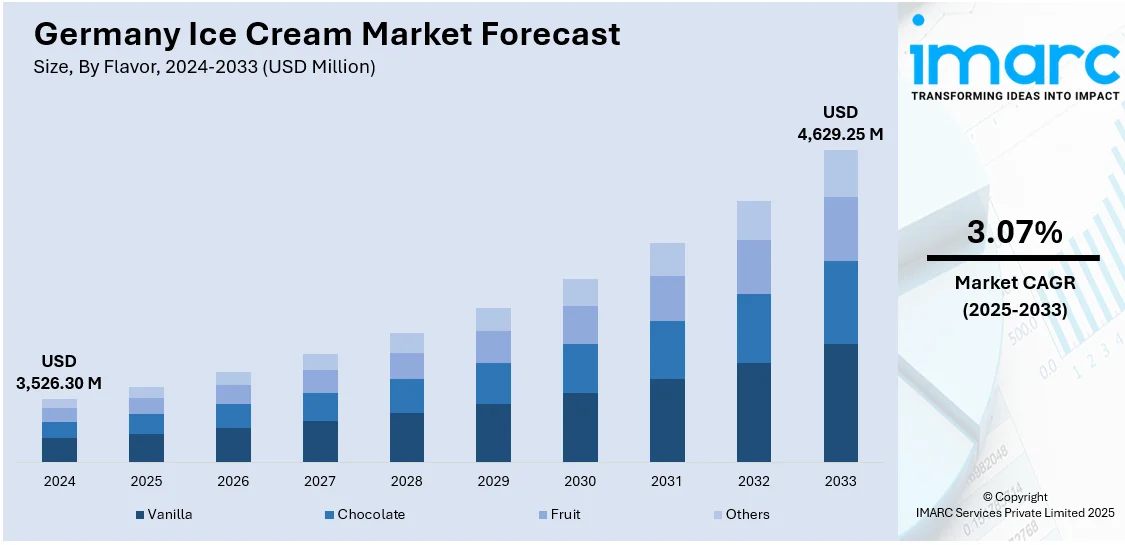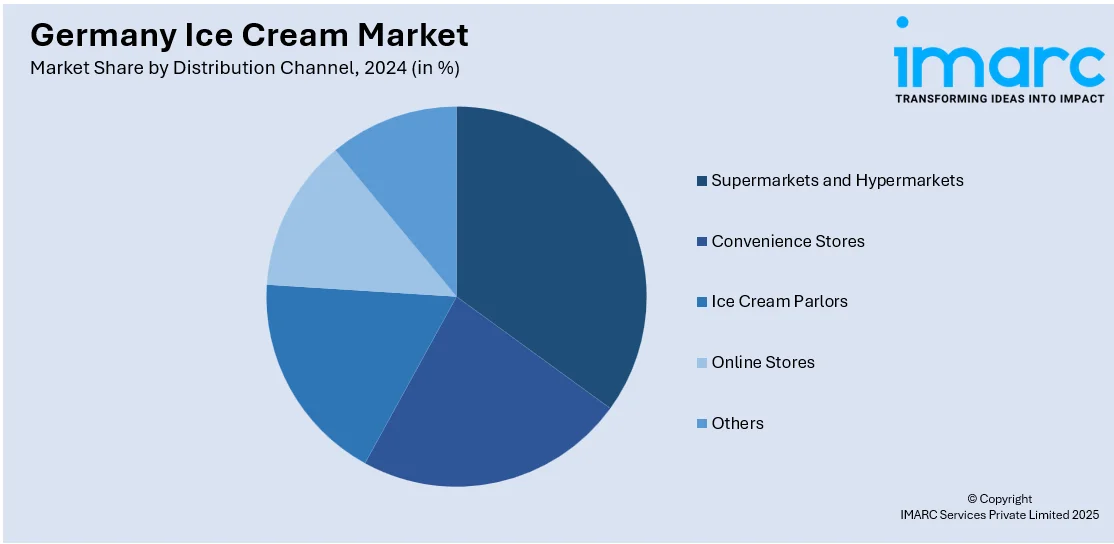
Germany Ice Cream Market Size, Share, Trends and Forecast by Flavor, Category, Product, Distribution Channel, and Region, 2025-2033
Germany Ice Cream Market Overview:
The Germany ice cream market size reached USD 3,526.30 Million in 2024. The market is projected to reach USD 4,629.25 Million by 2033, exhibiting a growth rate (CAGR) of 3.07% during 2025-2033. The market keeps growing steadily, fueled by accelerating consumer demand for premium, health-oriented, and sustainable products. Changing lifestyle habits, diet consciousness, and environmental awareness are transforming product innovation and consumer behavior in urban and country markets. Seasonal demand and rising per capita consumption further underpin retail and artisanal channels. These forces, along with increasing brand diversification and product differentiation, are elevating the overall competitiveness of the Germany ice cream market share.
|
Report Attribute
|
Key Statistics
|
|---|---|
|
Base Year
|
2024
|
|
Forecast Years
|
2025-2033
|
|
Historical Years
|
2019-2024
|
| Market Size in 2024 | USD 3,526.30 Million |
| Market Forecast in 2033 | USD 4,629.25 Million |
| Market Growth Rate 2025-2033 | 3.07% |
Germany Ice Cream Market Trends:
Increasing Demand for Premium and Artisanal Ice Cream
Germany is witnessing a significant change in consumer demand towards premium and artisanal ice cream, pointing to a heightened interest in high-quality, indulgent dessert experiences. Consumers are highly demanding products that focus on authenticity, craftsmanship, and clean-label formulations. This encompasses natural-ingredient-based ice cream, organic milk, and low-additive counts. Localized tastes and small-batch production are also on the rise, sought after by those who appreciate uniqueness and sensory nuance. The demand for experiential consumption is changing both product and presentation, with highly aesthetic textures and layered inclusions. Growing disposable incomes and heightened selectivity among consumers make this trend more powerful. Focus on indulgence and authenticity complements expansion of niche segments and seasonal products. Consequently, Germany ice cream market growth is being driven meaningfully by consumers' willingness to spend on products that are seen as premium, reflecting increased significance of flavor innovation and upscale consumption experience.

To get more information on this market, Request Sample
Growth of Health-Conscious and Functional Ice Cream Formats
Healthy lifestyles are ever more impacting dessert options throughout Germany, resulting in the growth of healthy and functional ice cream products. Today, customers expect food products that match nutritional objectives such as low-calorie, lower-sugar, and lactose-free varieties. This especially applies for individuals who are controlling dietary limitations or adopt plant-based diets. For instance, in February 2024, Magnum diversified its German plant-based range with the introduction of vegan Blueberry Cookie ice cream, including vanilla biscuit taste, cookie chunks, blueberry sorbet center, and vegan chocolate. Moreover, the trend is being met by manufacturers with alternative milk-based formulations such as almond, oat, and soy milks, in addition to those with added fiber, protein, or probiotics. These compete for both health-conscious adults and younger consumers looking for guilt-free pleasure. Cleaner labels and clear ingredient sourcing also now drive buying decisions. The wellness movement overall supports moderation and mindful use, opening the door for smaller packages and nutrient-dense foods. This emerging demand is not only expanding product portfolios but also driving ongoing research and development in the frozen dessert industry. Furthermore, Germany ice cream market trends now largely incorporate the inclusion of health-focused innovation as a driver of growth.
Sustainability and Eco-Friendly Packaging as Market Differentiators
Environmental consciousness is remaking consumer lifestyles in Germany, and the ice cream market is responding by embracing sustainability as a strategic imperative. Customers increasingly prefer brands that show environmentally conscious efforts of minimizing environmental footprint by using eco-friendly packaging and sustainable supplies. Innovations like biodegradable tubs, compostable spoons, and recyclable materials are becoming the norm for cutting-edge product lines. Besides packaging, sustainable ingredient sourcing—like fair trade-certified cocoa or regenerative farm-sourced dairy is on the rise. Such initiatives resonate particularly with environmentally aware Millennials and Gen Z consumers, who highly value values-driven purchasing choices. Carbon footprint and green certificate transparency is also impacting brand loyalty and trust. Also, sustainability efforts cross over with localism as manufacturers promote regional supply chains to reduce transport-related emissions. As these trends go mainstream, Germany ice cream market expansion is more and more being driven by a business's capacity to fold environmental concerns into the product life cycle and, ultimately, turn sustainability into a market differentiator.
Germany Ice Cream Market Segmentation:
IMARC Group provides an analysis of the key trends in each segment of the market, along with forecasts at the country and regional levels for 2025-2033. Our report has categorized the market based on flavor, category, product, and distribution channel.
Flavor Insights:
- Vanilla
- Chocolate
- Fruit
- Others
The report has provided a detailed breakup and analysis of the market based on the flavor. This includes vanilla, chocolate, fruit, and others.
Category Insights:
- Impulse Ice Cream
- Take-Home Ice Cream
- Artisanal Ice Cream
A detailed breakup and analysis of the market based on the category have also been provided in the report. This includes impulse ice cream, take-home ice cream, and artisanal ice cream.
Product Insights:
- Cup
- Stick
- Cone
- Brick
- Tub
- Others
The report has provided a detailed breakup and analysis of the market based on the product. This includes cup, stick, cone, brick, tub, and others.
Distribution Channel Insights:

- Supermarkets and Hypermarkets
- Convenience Stores
- Ice Cream Parlors
- Online Stores
- Others
A detailed breakup and analysis of the market based on the distribution channel have also been provided in the report. This includes supermarkets and hypermarkets, convenience stores, ice cream parlors, online stores, and others.
Regional Insights:
- Western Germany
- Southern Germany
- Eastern Germany
- Northern Germany
The report has also provided a comprehensive analysis of all the major regional markets, which include Western Germany, Southern Germany, Eastern Germany, and Northern Germany.
Competitive Landscape:
The market research report has also provided a comprehensive analysis of the competitive landscape. Competitive analysis such as market structure, key player positioning, top winning strategies, competitive dashboard, and company evaluation quadrant has been covered in the report. Also, detailed profiles of all major companies have been provided.
Germany Ice Cream Market News:
- In July 2024, Ferrero introduced Nutella Gelato in Germany with hazelnut cream and chocolate lavish layers. The high-end ice cream responds to the increasing demand for premium, high-quality frozen treats in Germany, according to changing consumer trends for artisanal texture and high-end flavor profiles in the competitive and growing German ice cream industry.
Germany Ice Cream Market Report Coverage:
| Report Features | Details |
|---|---|
| Base Year of the Analysis | 2024 |
| Historical Period | 2019-2024 |
| Forecast Period | 2025-2033 |
| Units | Million USD |
| Scope of the Report |
Exploration of Historical Trends and Market Outlook, Industry Catalysts and Challenges, Segment-Wise Historical and Future Market Assessment:
|
| Flavors Covered | Vanilla, Chocolate, Fruit, Others |
| Categories Covered | Impulse Ice Cream, Take-Home Ice Cream, Artisanal Ice Cream |
| Products Covered | Cup, Stick, Cone, Brick, Tub, Others |
| Distribution Channels Covered | Supermarkets and Hypermarkets, Convenience Stores, Ice Cream Parlors, Online Stores, Others |
| Regions Covered | Western Germany, Southern Germany, Eastern Germany, Northern Germany |
| Customization Scope | 10% Free Customization |
| Post-Sale Analyst Support | 10-12 Weeks |
| Delivery Format | PDF and Excel through Email (We can also provide the editable version of the report in PPT/Word format on special request) |
Key Questions Answered in This Report:
- How has the Germany ice cream market performed so far and how will it perform in the coming years?
- What is the breakup of the Germany ice cream market on the basis of flavor?
- What is the breakup of the Germany ice cream market on the basis of category?
- What is the breakup of the Germany ice cream market on the basis of product?
- What is the breakup of the Germany ice cream market on the basis of distribution channel?
- What is the breakup of the Germany ice cream market on the basis of region?
- What are the various stages in the value chain of the Germany ice cream market?
- What are the key driving factors and challenges in the Germany ice cream?
- What is the structure of the Germany ice cream market and who are the key players?
- What is the degree of competition in the Germany ice cream market?
Key Benefits for Stakeholders:
- IMARC’s industry report offers a comprehensive quantitative analysis of various market segments, historical and current market trends, market forecasts, and dynamics of the Germany ice cream market from 2019-2033.
- The research report provides the latest information on the market drivers, challenges, and opportunities in the Germany ice cream market.
- Porter's five forces analysis assist stakeholders in assessing the impact of new entrants, competitive rivalry, supplier power, buyer power, and the threat of substitution. It helps stakeholders to analyze the level of competition within the Germany ice cream industry and its attractiveness.
- Competitive landscape allows stakeholders to understand their competitive environment and provides an insight into the current positions of key players in the market.
Need more help?
- Speak to our experienced analysts for insights on the current market scenarios.
- Include additional segments and countries to customize the report as per your requirement.
- Gain an unparalleled competitive advantage in your domain by understanding how to utilize the report and positively impacting your operations and revenue.
- For further assistance, please connect with our analysts.
 Request Customization
Request Customization
 Speak to an Analyst
Speak to an Analyst
 Request Brochure
Request Brochure
 Inquire Before Buying
Inquire Before Buying




.webp)




.webp)












